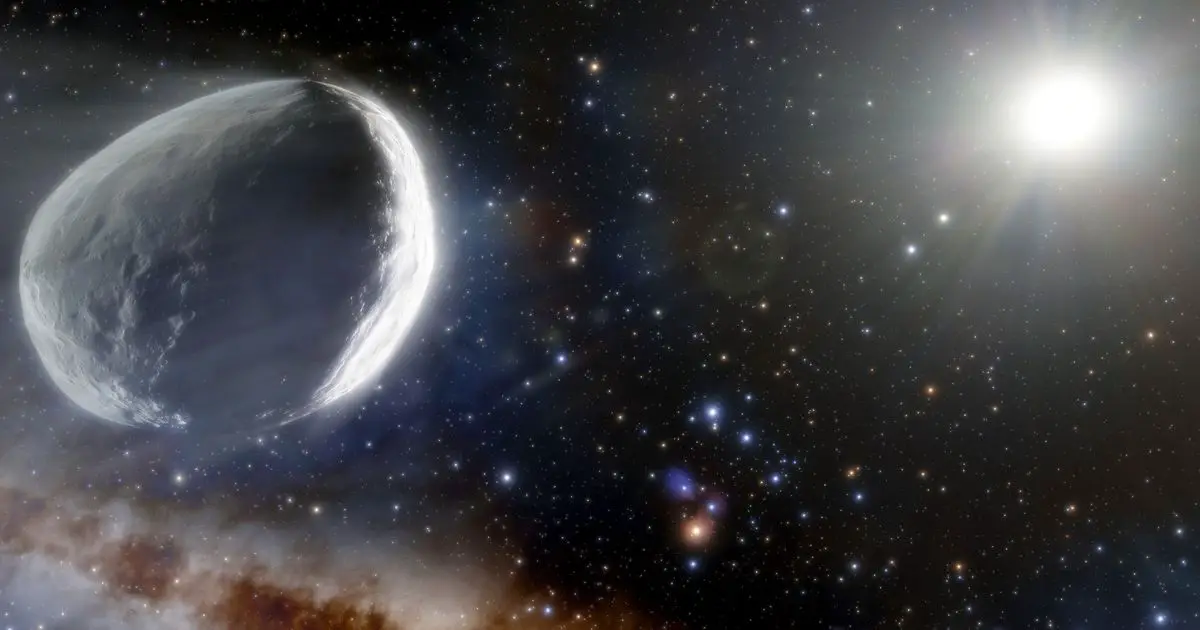Comet 2014 UN271/(Bernardinelli-Bernstein) is the largest ever recorded by scientists and is twice the size of the last celestial giant to hold the tile, Hale-Bopp
Image: NOIRLab/NSF/AURA/J. da Silva (Space Engine))
A megacomet the size of a small planet has been confirmed as the largest ever seen by scientists.
The first image of Comet 2014 UN271/(Bernardinelli-Bernstein) was spotted nearly eight years ago with shocked experts predicting it was among the biggest ever seen.
At the time, early estimates thought it was around 60-230 miles wide.
Now more precise calculations have indicated it is 85 miles across – around the same distance from London to Birmingham.
It is more than ten times the size of the meteorite believed to have wiped out the dinosaurs more than 65 million years ago, put at around seven miles.
But despite its massive size there is no need for concern as its orbit means Comet 2014 UN271 will never cross Saturn, about 746 million miles away.
Dr Emmanuel Lellouch of the Paris Observatory told New Scientist : “We have confirmed the estimate.
“It’s the biggest comet from the Oort Cloud ever found.”
(
Image:
(Getty Images/iStockphoto)
Dr Lellouch and his team discovered its true size by using the Atacama Large Millimeter/submillimeter Array (ALMA) in Chile which examined the radiation created by the comet and allowed them to calculate its surface area.
The Oort Cloud, according to Nasa, is the most distant region of our solar system and is described as a “big, thick-walled bubble made of icy pieces of space debris.”
Some of the pieces are the size of mountains and larger, and there could be trillions of items.
The comet is twice the size of the last celestial giant to hold the tile, Hale-Bopp, which was discovered in 1995 by two amateur astronomers, Alan Hale in New Mexico and Thomas Bopp in Arizona.
Mr Hale told Time magazine in 1997: “As soon as I looked I saw a fuzzy object nearby. It was strange, because I’d looked at M70 a couple of weeks earlier and the object hadn’t been there.”
(
Image:
(Getty Images/iStockphoto)
The comet was visible to the naked eye for around 18 months, delighting stargazers in the 1990s.
Another space object known as 95P/Chiron, which orbits between Saturn and Uranus, is technically larger at 130 miles but scientists cannot decide if it is a comet or a small planet.
It comes as NASA revealed it is considering whether to kill off the International Space Station (ISS) by crashing it into the ocean within the next ten years.
The space agency plans to take the lab out of orbit in January 2031 by sending it to a “spacecraft cemetery”.
Point Nemo, Latin for “no-one”, is the ideal spot to sink decommissioned satellites, space stations and rockets as it is the furthest point from land on Earth.
The nearest humans are the astronauts in the ISS who fly just under 400km above the zone which has been used as a dumping ground by space agencies since 1971.
US President Joe Biden promised to keep running the ISS until 2030 but its long term future is undecided as it gets older and unsustainable to repair.
read more
read more

